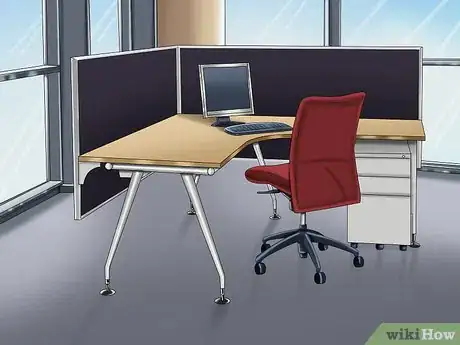This article was co-authored by Maureen Taylor. Maureen Taylor is the CEO and Founder of SNP Communications, a leadership communications company based in the San Francisco Bay Area. She has been helping leaders, founders, and innovators in all sectors hone their messaging and delivery for almost 30 years, and has worked with leaders and teams at Google, Facebook, Airbnb, SAP, Salesforce, and Spotify.
This article has been viewed 87,557 times.
How much personal space an individual needs is just that: personal. Each person has their own different bubble.[1] And that bubble is different for each person who approaches. In a work environment, however, it’s best to tread carefully when making someone feel uncomfortable. Use a few simple approaches to get a colleague out of your personal space.
Steps
Analyzing Your Workplace
-
1Create a buffer. Use your natural office environment to separate yourself from someone else. Be sure to use natural cubicle dividers and desks to get more room. Stand nearer to larger objects like water coolers so there is less angle to approach you.
-
2Recognize accidents. If you feel the personal space violation was due to clumsiness or a simple mistake, simply dismiss the situation. It’s far too easy to become defensive about a situation that was completely incidental or unintentional.Advertisement
-
3Appreciate other cultures. If there is a diverse environment at your office, it’s likely some people find touching to be a valid form of expression, a means of connection and communication. It is probably how they talk to their friends and family. If it's not inappropriate (a tap on the shoulder, a pat on the back) and if it's not bothering you, you may choose to accept their invasion of your space.EXPERT TIPMaureen Taylor is the CEO and Founder of SNP Communications, a leadership communications company based in the San Francisco Bay Area. She has been helping leaders, founders, and innovators in all sectors hone their messaging and delivery for almost 30 years, and has worked with leaders and teams at Google, Facebook, Airbnb, SAP, Salesforce, and Spotify.Corporate Communications Advisor

 Maureen Taylor
Maureen Taylor
Corporate Communications AdvisorIt can take practice to understand another point of view. Maureen Taylor, the CEO and founder of SNP Communications, says: "Seeking understanding is the hardest thing we work on. It's the hardest thing to teach, and the hardest thing for people to get, because people are used to thinking about themselves."
-
4Consider the environment. If you are forced into a closely grouped situation, realize its innocuous nature. Places like elevators and group meetings often result in people being within closer proximity to one another.
-
5Ignore the issue. Unless the touch is inappropriate, it may be best to chalk it up to harmless interaction. Don't turn around or react to the infringement of your personal space. Do not stop what you are doing. Maintain your focus and pretend that nothing happened. If it persists, you may need to redirect to a different method.
-
6Document the interaction. If you feel there was a violation of your personal space, particularly if you were touched, it may be necessary to elevate the issue. When you feel it is necessary, bring it up to your manager or speak to Human Resources. Bring your documentation, and let them deal with the person.
-
7Be cognizant of your status. Consider the office environment – a supervisor can walk right into a subordinate’s office, but the respect is not always reciprocal. Some workplace situations can’t be controlled, and the more senior the person invading your personal space, the less likely you’ll be able to control the situation.[2]
Talking to Your Coworker
-
1Tell them about personal space constructs. Let your coworker know there are varying distances in which people feel either comfortable or uncomfortable. Providing this information may be a wakeup call if they are unaware.
- Public space – Research shows this distance is acceptable for all, and roughly about 12 feet.
- Social space – This, anywhere from 4-12 feet, is where people should stand when talking to one another.
- Personal space – When people get in your actual personal space, which is from 1.5ft to 4ft, they are in an area for those displaying aggressiveness or intimacy.
- Intimate space – This is the closest someone can be, less than 1.5ft, and it’s a spot reserved for only those with whom we are intimate. Getting this close is definitely an issue.
-
2Ask the person who is invading your space to back away. Explain that you are uncomfortable. You shouldn't make a scene at your workplace, but do be clear and firm. It may take a while for them to break the habit. Continue to remind them if they continue to do it. To say "No" is absolutely acceptable and appropriate.
-
3Let them know they are making you feel uncomfortable. They may simply be unaware of what they’re doing. Or they may believe you two are more closely associated, permitting the closer interaction. Try one of the following approaches:
- You are too close to me right now. It’s awkward for you to be this close to me.
- Do you realize being this close is a social faux pas?
- I’d like to have a bit more room between us when talking. I just don’t like people in my bubble.
Taking Physical Action
-
1Send nonverbal cues. It may be best to send some cues your personal space is being invaded. Try to convey a need for separation with a few of the following examples:
- Scoot your chair backward. Create the space to stretch out.
- Swing your legs while sitting. The potential for being kicked implies a need for space.
- Avoid eye-contact while talking face-to-face. This will show the coworker your disinterest and desire to be involved with something else.
- Fold your arms across your chest. This posture exudes defensiveness and a desire to avoid the situation.[3]
-
2Take a step back. There is no mistaking the creation of space in this case. Your movement is literally saying, “I’d like you not to be so close.” Body language may or may not work, but movement is an easy way to communicate your displeasure.
-
3Isolate yourself. Avoid the situations entirely and ensure they can’t be in your space. Work in different areas when possible, use public situations as little as you can. Try focusing intently on your work so that nobody can interfere with your space at all.[4]
Warnings
- If you have asked that a behavior stop and it has not stopped, and especially if you feel that it is inappropriate, tell your manager right away.⧼thumbs_response⧽
- Retaliating against a co-worker could threaten your job. Keep your complaints on a professional level and do not share with your entire staff. Keep it confidential within the proper management.⧼thumbs_response⧽
References
About This Article
It may be awkward to get a coworker to respect your personal space, but there are simple things you can do to communicate you need more room, like taking a step back during a conversation. You might also try putting up cubicle dividers to create a buffer. If these methods don’t work, you may have to talk to your coworker directly. You can say something like, “I feel awkward with you this close, could you give me more room?” If your coworker continues to ignore your boundaries, you should seek outside help. For advice on how to take the problem to Human Resources, scroll down.







































































